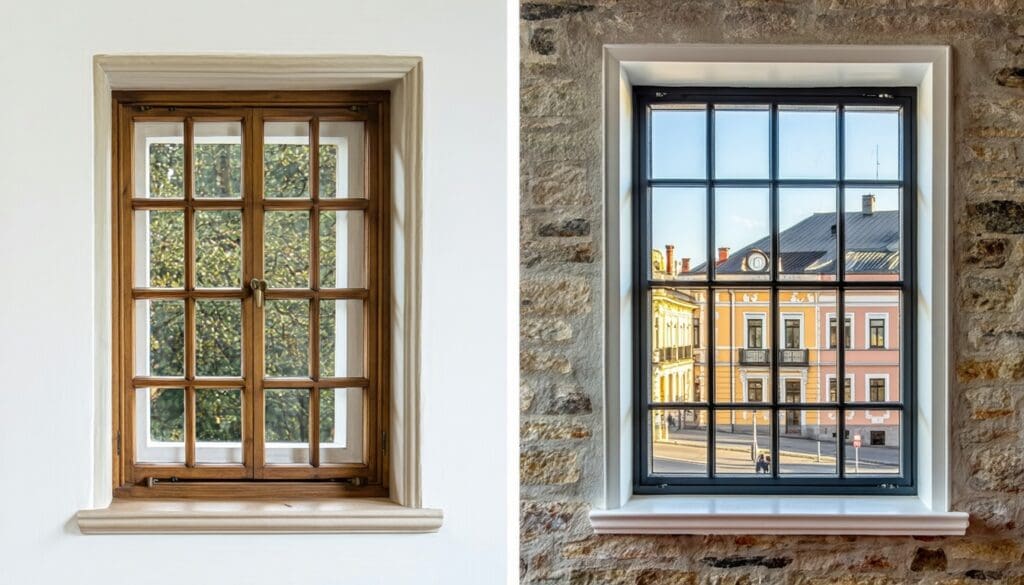Georgia’s architectural heritage is one of the country’s greatest assets. From the ornate balconies of Tbilisi to the stone façades of Telavi and the elegant wooden structures in Batumi, historic buildings are central to Georgia’s cultural identity and tourism economy. Find out in this post why Vacuum Glazing Is Better Than Slim Double Glazing
But as energy prices rise and sustainability becomes a priority, there’s growing pressure to improve the performance of these older buildings—especially their windows. Replacing single glazing with modern alternatives can dramatically reduce heat loss, yet it must be done without damaging the building’s historic appearance.
For many years, slim double glazing was seen as a practical compromise. But now, thanks to new innovations like LandVac vacuum glazing, Georgian property owners and conservation specialists have access to a better solution—one that doesn’t require compromise at all.

Above: The window on the left has been restored with slim double glazing, the thick profiles look ugly and inauthentic. The window on the right has authentic looking slim profiles and looks like single glazing – it has been restored using LandVac vacuum glazing.
What Is Slim Double Glazing—and Where Does It Fall Short?
Slim double glazing refers to insulated glass units that are thinner than standard double glazing, typically between 10–14mm thick. It was developed to fit into traditional window frames without requiring full frame replacements, which made it appealing for heritage projects.
However, slim double glazing has its limitations:
Moderate thermal insulation: Typical U-values range from 1.5 to 1.8 W/m²K—not much better than single glazing by modern standards.
Visible spacer bars: These can disrupt the clean appearance of heritage windows.
Limited lifespan: Gas-filled units often last only 15–20 years before seal failure becomes an issue.
For Georgian buildings that need both preservation and performance, these drawbacks can be significant.
LandVac Vacuum Glazing: The Smarter Alternative
LandVac is a high-performance vacuum glazing unit that’s just 8.3mm thick—even thinner than many slim double-glazed units. But what makes it special is what’s inside: a complete vacuum between two panes of tempered glass. This vacuum eliminates almost all heat transfer, providing U-values as low as 0.4 W/m²K, far superior to slim double glazing.
Other key benefits of LandVac:
No visible spacer bars: The edges are discreet and clean, preserving the traditional look.
Condensation-free: No fogging, even in Georgia’s humid or cold regions.
Exceptional sound insulation: Perfect for homes near busy streets or public squares.
Long lifespan: Over 25 years, with no inert gases to leak or degrade.
Whether you’re restoring a family home in Kutaisi or upgrading windows in a cultural site in Tbilisi, LandVac offers performance and heritage compliance in one.
Side-by-Side Comparison: Slim Double Glazing vs. LandVac
| Feature | Slim Double Glazing | LandVac Vacuum Glazing |
|---|---|---|
| Total Thickness | ~10–14mm | 8.3mm |
| U-value | ~1.5–1.8 W/m²K | 0.4–0.7 W/m²K |
| Spacer Visibility | Often visible | Invisible |
| Fit in Original Frames | Usually possible | Easily compatible |
| Aesthetic Integrity | Moderate | High |
| Lifespan | 15–20 years | 25+ years |
| Noise Insulation | Basic | Excellent |
Why LandVac Is Ideal for Historic Georgian Buildings
Georgia’s historic architecture includes a wide range of materials and styles—timber sash windows, steel-framed windows, and hand-carved stone surrounds. LandVac’s slim profile allows it to be fitted directly into most traditional frames without changing their look or structure.
Here’s why LandVac is especially well-suited to Georgian renovation projects:
Preserves historic detail: No thick frames or reflective coatings to disrupt visual harmony.
Improves year-round comfort: Keeps homes warm in winter and cooler in summer—essential for Georgia’s continental climate.
Supports energy efficiency goals: Ideal for buildings seeking EU funding, green certification, or long-term cost savings.
Conservation officer-friendly: In many cases, LandVac’s appearance is indistinguishable from single glazing, making it easier to get planning approval for protected properties.
Already Being Used in Heritage Projects Across Europe
LandVac has been successfully used in listed buildings, museums, and heritage hotels across the EU and UK. Its blend of modern insulation and classic appearance makes it a preferred choice for architects and conservation officers alike.
For Georgia, which is increasingly involved in EU-aligned renovation initiatives, LandVac is perfectly positioned to meet both conservation and performance standards.
Conclusion: Upgrade Without Compromise
Slim double glazing helped bridge the gap between old-world style and modern expectations—but it’s no longer the best option. With LandVac vacuum glazing, Georgian property owners can achieve true energy performance while respecting the original character of their buildings.
If you’re renovating a historic home, restoring a public building, or working on a tourism-focused property, LandVac offers you the best of both worlds.
Contact us today for expert advice on using LandVac in Georgia —or request a technical guide to see how it fits into your renovation plans.